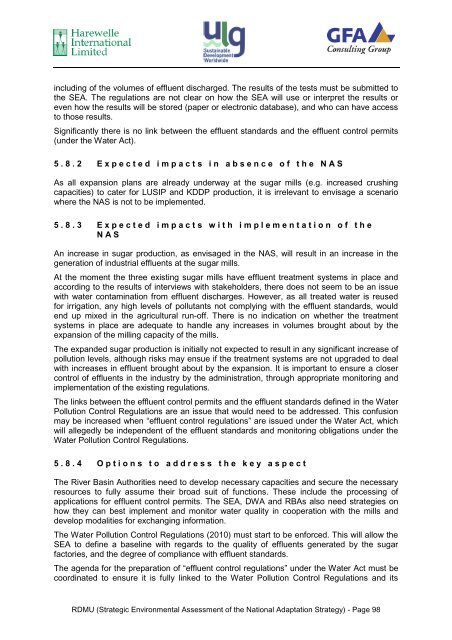Service Contract No 2007 / 147-446 Strategic ... - Swaziland
Service Contract No 2007 / 147-446 Strategic ... - Swaziland
Service Contract No 2007 / 147-446 Strategic ... - Swaziland
- No tags were found...
You also want an ePaper? Increase the reach of your titles
YUMPU automatically turns print PDFs into web optimized ePapers that Google loves.
including of the volumes of effluent discharged. The results of the tests must be submitted tothe SEA. The regulations are not clear on how the SEA will use or interpret the results oreven how the results will be stored (paper or electronic database), and who can have accessto those results.Significantly there is no link between the effluent standards and the effluent control permits(under the Water Act).5.8.2 Expected impacts in absence of the NASAs all expansion plans are already underway at the sugar mills (e.g. increased crushingcapacities) to cater for LUSIP and KDDP production, it is irrelevant to envisage a scenariowhere the NAS is not to be implemented.5.8.3 Expected impacts with implementation of theNASAn increase in sugar production, as envisaged in the NAS, will result in an increase in thegeneration of industrial effluents at the sugar mills.At the moment the three existing sugar mills have effluent treatment systems in place andaccording to the results of interviews with stakeholders, there does not seem to be an issuewith water contamination from effluent discharges. However, as all treated water is reusedfor irrigation, any high levels of pollutants not complying with the effluent standards, wouldend up mixed in the agricultural run-off. There is no indication on whether the treatmentsystems in place are adequate to handle any increases in volumes brought about by theexpansion of the milling capacity of the mills.The expanded sugar production is initially not expected to result in any significant increase ofpollution levels, although risks may ensue if the treatment systems are not upgraded to dealwith increases in effluent brought about by the expansion. It is important to ensure a closercontrol of effluents in the industry by the administration, through appropriate monitoring andimplementation of the existing regulations.The links between the effluent control permits and the effluent standards defined in the WaterPollution Control Regulations are an issue that would need to be addressed. This confusionmay be increased when “effluent control regulations” are issued under the Water Act, whichwill allegedly be independent of the effluent standards and monitoring obligations under theWater Pollution Control Regulations.5.8.4 Options to address the key aspectThe River Basin Authorities need to develop necessary capacities and secure the necessaryresources to fully assume their broad suit of functions. These include the processing ofapplications for effluent control permits. The SEA, DWA and RBAs also need strategies onhow they can best implement and monitor water quality in cooperation with the mills anddevelop modalities for exchanging information.The Water Pollution Control Regulations (2010) must start to be enforced. This will allow theSEA to define a baseline with regards to the quality of effluents generated by the sugarfactories, and the degree of compliance with effluent standards.The agenda for the preparation of “effluent control regulations” under the Water Act must becoordinated to ensure it is fully linked to the Water Pollution Control Regulations and itsRDMU (<strong>Strategic</strong> Environmental Assessment of the National Adaptation Strategy) - Page 98
















